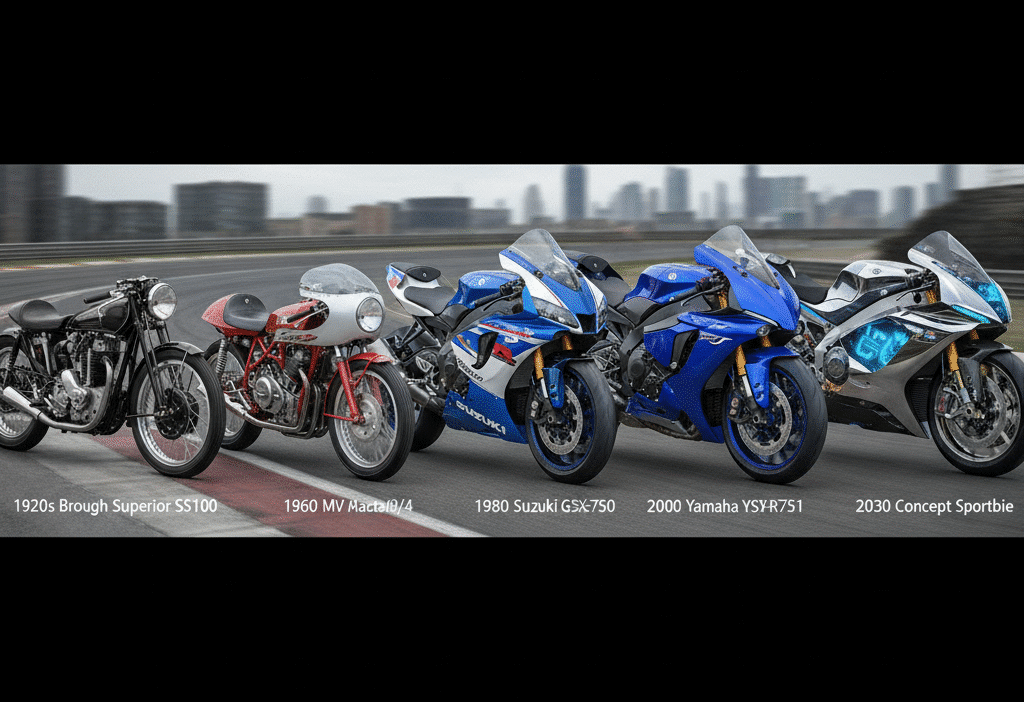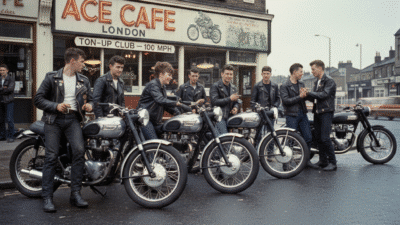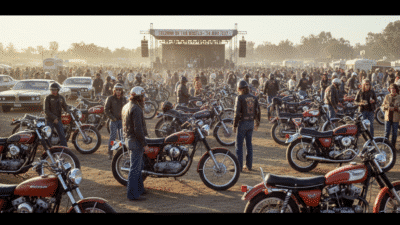From the roar of an engine to the blur of speed, few machines ignite the senses quite like a sport bike. These two-wheeled marvels represent the pinnacle of motorcycle engineering, designed for exhilarating performance, precision handling, and breathtaking aesthetics. The development of sport bikes is not merely a tale of horsepower and speed; it is a profound journey of human ingenuity, relentless innovation, and an unwavering pursuit of automotive perfection. This evolution mirrors a deep-seated desire to push boundaries, translating race-bred technology from the circuit to the street, and shaping the very culture of motorcycling itself. Join us as we trace this incredible lineage, from humble beginnings to the sophisticated super machines of today.
The Genesis of Speed: Early 20th Century Innovations
The concept of a “sport bike” didn’t emerge fully formed; it was a gradual crystallization of ideas around speed and performance in the nascent days of motorcycling. Early motorcycles, often little more than motorized bicycles, quickly became platforms for experimentation. The thrill of competition, particularly on emerging circuits and road races, drove initial advancements.
The Pioneer Racers and Early Designs
The early 1900s saw the birth of organized motorcycle racing, with events like the Isle of Man TT serving as crucibles for performance development. Racers demanded more power, better handling, and greater reliability. Manufacturers responded by strengthening frames, improving basic suspension systems, and experimenting with engine configurations. While rudimentary by modern standards, these early machines laid the groundwork for dedicated performance motorcycles. Companies like Norton, Triumph, and Indian were among the first to gain prominence, their racing successes directly influencing consumer models. These pioneering efforts demonstrated the potential for motorcycles to be more than just transportation; they could be vehicles of exhilarating speed and competitive prowess, much like the iconic starts in racing history across other motorsport disciplines.
Engine Development: From Singles to Twins
Initially, most motorcycles featured single-cylinder engines, relatively simple and easy to maintain. However, the hunger for more power soon led to the exploration of multi-cylinder layouts. V-twin engines, in particular, gained traction for their compact design and improved power delivery. Harley-Davidson and Indian famously championed the V-twin, creating powerful machines that dominated early races. These early engines, though lacking the sophisticated electronics of today, represented significant engineering challenges and breakthroughs, pushing the limits of metallurgy and mechanical design. Designers also began considering rider ergonomics, albeit in a rudimentary fashion, to enhance control at higher speeds, moving away from upright touring positions towards a more aggressive, forward-leaning stance.

Post-War Boom: The Rise of Performance
The aftermath of World War II ushered in a new era of prosperity and technological advancement. Motorcycle manufacturing, honed by wartime production, pivoted back to civilian markets with renewed vigor. This period saw a significant leap in performance and design, transforming motorcycles from utilitarian transports into desirable leisure and performance machines.
British Dominance: Café Racers and Their Influence
The 1950s and early 1960s were dominated by British manufacturers like Triumph, Norton, and BSA. Their powerful parallel-twin engines and robust chassis formed the basis of the legendary “café racer” culture. Young riders would modify their standard bikes for speed, stripping down unnecessary components, fitting clip-on handlebars, rear-set footpegs, and performance exhausts. The goal was simple: to go “ton-up” (hit 100 mph) and outrun rivals from one café to the next. This subculture profoundly influenced sport bike design, solidifying the aggressive riding position and minimalist aesthetic as hallmarks of performance motorcycles. The café racer movement proved that a demand existed for motorcycles built purely for speed and style.
Japanese Entry: Innovation and Accessibility
While British bikes defined the early post-war sport scene, the late 1960s witnessed the groundbreaking entry of Japanese manufacturers. Honda’s CB750 Four, introduced in 1969, was a watershed moment. It offered an inline-four engine, disc brakes, and electric start – features that were revolutionary for a mass-produced motorcycle. The CB750 combined high performance with exceptional reliability and affordability, characteristics that the British manufacturers struggled to match. This bike not only democratized performance motorcycling but also set a new standard for engineering excellence, laying the foundation for Japan’s future dominance in the sport bike segment. This shift in manufacturing power reflected a broader trend in automotive innovation, where new players disrupted established norms with fresh approaches to design and production, much like the evolution seen in car design.
The Golden Era: 70s and 80s Powerhouses
The 1970s and 1980s represent a truly “golden era” in sport bike development. Japanese manufacturers, having proven their prowess, began a relentless pursuit of performance, pushing horsepower figures to unprecedented levels and refining chassis dynamics. The competition was fierce, leading to rapid advancements year after year.
Multi-Cylinder Mania: The Japanese Influx
The success of the Honda CB750 opened the floodgates. Kawasaki responded with the legendary Z1 in 1972, a 900cc inline-four that was faster and more powerful. Suzuki soon followed with its GS series, and Yamaha with its XS models. The focus was firmly on multi-cylinder engines – inline-fours, sometimes even sixes – delivering smooth, high-revving power. These bikes transformed motorcycling, offering speeds previously only imagined. The raw power and advanced engineering made these machines instant icons, capturing the imagination of riders globally. This era also saw early attempts to integrate race-derived components into street bikes, blurring the lines between pure racing machines and road-legal performance motorcycles.
Aerodynamics and Fairings: Form Meets Function
As speeds climbed, the need for better aerodynamics became paramount. Full fairings, once exclusive to race bikes, began appearing on production models. These fairings reduced wind resistance, improved stability at high speeds, and offered riders greater protection from the elements. While initially bulky, designers quickly refined them, integrating them seamlessly into the bike’s overall aesthetic. This period also saw significant strides in chassis technology. Steel frames became stiffer, and suspension components, though still basic by today’s standards, improved damping and adjustability. The introduction of monoshock rear suspension systems, pioneered in racing, began to trickle down to street bikes, offering superior handling and comfort. This relentless pursuit of performance led to iconic models like the Kawasaki GPz900R, the Suzuki GSX-R750, and the Yamaha FZ750, machines that defined the term “sport bike” for a generation.

The Digital Revolution: 90s to Early 2000s
The transition from the 20th to the 21st century marked another paradigm shift in sport bike development: the integration of advanced electronics. While raw power remained a key metric, the focus broadened to include how effectively that power could be controlled and exploited. This era laid the groundwork for the hyper-intelligent machines we see today.
Fuel Injection and Electronic Management
Carburettors, long the standard for fuel delivery, began to be phased out in favor of electronic fuel injection (EFI). EFI offered numerous advantages: precise fuel metering for optimal combustion, improved throttle response, better fuel economy, and lower emissions. It also paved the way for sophisticated engine management systems that could adapt to varying conditions. Manufacturers also began experimenting with rudimentary traction control and anti-lock braking systems (ABS), recognizing that managing immense power required intelligent assistance. These electronic aids, initially rudimentary, were the precursors to the highly advanced rider assistance systems found on modern superbikes, demonstrating an early understanding of the need for electronic governance in high-performance vehicles.
Aluminum Frames and Radical Design
The 1990s witnessed the widespread adoption of aluminum as the material of choice for sport bike frames. Aluminum offered a superior stiffness-to-weight ratio compared to steel, leading to lighter, more agile chassis. Twin-spar and perimeter frames became common, designed to optimize rigidity and house increasingly compact engines. Suspension technology also saw significant advancements, with upside-down (inverted) forks becoming standard, offering greater rigidity and improved damping performance. Braking systems evolved with multi-piston calipers and larger diameter discs providing unprecedented stopping power.
The designs of this era became more aggressive and aerodynamic. Bikes like the Honda CBR900RR Fireblade, introduced in 1992, redefined the superbike category by emphasizing lightness and balanced handling over sheer engine capacity. Yamaha’s YZF-R1, launched in 1998, set new benchmarks for power-to-weight ratios and compact design, initiating the “liter bike” wars that would dominate the next decade. These machines represented a blend of cutting-edge engineering and radical aesthetics, solidifying the sport bike’s image as a high-tech performance tool. The constant drive for innovation in motorcycles parallels advancements in other automotive sectors, such as the most significant car innovations of the 20th century.

Modern Superbikes: The Apex of Technology and Performance
Today’s sport bikes are engineering marvels, blending raw power with an arsenal of electronic rider aids and advanced materials. They are a direct descendant of decades of racing innovation, with technology often trickling down directly from top-tier competitions like MotoGP.
Advanced Electronics: Traction Control, ABS, Ride Modes
The most significant leap in modern sport bikes is the omnipresence of sophisticated electronic rider aids. Inertial Measurement Units (IMUs) now precisely track a bike’s lean angle, pitch, and yaw, feeding data to complex systems. This enables cornering ABS, lean-sensitive traction control, slide control, wheelie control, and launch control – all working seamlessly to optimize performance and enhance safety. Multiple ride modes allow riders to tailor power delivery, throttle response, and electronic intervention levels to suit different conditions, from track days to street riding. These systems are so advanced they can even predict and react to potential slides, giving riders a superhuman level of control. The evolution of these electronic aids on street bikes directly reflects advancements seen in professional racing, particularly MotoGP’s evolution of electronic aids.
Material Science: Carbon Fiber and Exotic Alloys
The pursuit of lightness and strength has led to the widespread use of exotic materials. Carbon fiber, once exclusive to aerospace and top-tier racing, is now found in wheels, fairings, and structural components of high-end superbikes. Titanium is used for exhaust systems and fasteners, while magnesium alloys reduce weight in engine casings and wheels. These materials not only reduce overall mass but also contribute to superior rigidity and improved handling dynamics, allowing engineers to push the boundaries of performance further than ever before. This attention to material science underlines the commitment to maximizing every ounce of performance and durability.
Aerodynamic Sophistication: Winglets and Aero Kits
Aerodynamics have evolved far beyond simple fairings. Modern superbikes feature complex aero packages, often including winglets derived directly from MotoGP, designed to generate downforce at high speeds. This downforce improves front-end grip during acceleration, reduces wheelie tendencies, and enhances stability in fast corners. The shapes of fairings, screens, and even rider posture are meticulously sculpted in wind tunnels to minimize drag and optimize airflow, showcasing the intricate relationship between design and function. Bikes like the Ducati Panigale V4R or the BMW S1000RR represent the cutting edge of this integration, with every surface serving a precise aerodynamic purpose. The development of high-performance bikes like Yamaha YZR-M1 Rossi’s MotoGP bike highlights the constant aerodynamic refinement that filters down to production models.

Pros and Cons
| Pros | Cons |
|---|---|
| – Exhilarating Performance: Unmatched acceleration and top speed. | – High Purchase and Maintenance Costs: Premium parts and complex systems. |
| – Precision Handling: Superb agility, braking, and cornering capabilities. | – Aggressive Ergonomics: Can be uncomfortable for long rides or daily commuting. |
| – Advanced Technology: Cutting-edge electronics enhance safety and control. | – High Insurance Premiums: Due to performance and perceived risk. |
| – Iconic Aesthetics: Visually stunning designs that turn heads. | – Demanding Riding Style: Requires skill and focus, especially at speed. |
| – Direct Race Heritage: Benefit from direct trickle-down technology from motorsport. | – Limited Practicality: Often poor passenger comfort and minimal storage. |
The Future of Sport Bikes: Beyond Internal Combustion
The journey of the sport bike is far from over. As the automotive world grapples with environmental concerns and new technological frontiers, sport bikes are also poised for a revolutionary transformation.
Electric Sport Bikes: Performance and Sustainability
The most significant shift on the horizon is the widespread adoption of electric propulsion. Electric sport bikes, such as those from Zero Motorcycles or Energica, already offer instant torque, silent operation, and impressive acceleration, often surpassing their internal combustion counterparts in initial thrust. As battery technology improves, addressing range and charging times, electric sport bikes are set to become formidable contenders. They offer a future where exhilarating performance can coexist with zero emissions, appealing to a new generation of environmentally conscious riders without sacrificing the thrill. This transition will redefine what a “sport bike” sounds and feels like, moving beyond the traditional exhaust note to a symphony of electric whine and wind.
Autonomous Features and Connectivity
While full autonomy on a motorcycle presents unique challenges, semi-autonomous features and advanced connectivity are becoming increasingly common. Adaptive cruise control, blind-spot monitoring, and even radar-guided collision avoidance systems are already making their way onto premium motorcycles. Future sport bikes could feature even more integrated smart technologies, offering real-time performance analytics, adaptive suspension systems that learn rider preferences, and seamless integration with smart devices for navigation and communication. The convergence of automotive and information technology will redefine the riding experience, making it safer, more intuitive, and highly personalized.
New Design Paradigms and User Experiences
The move to electric powertrains will liberate designers from the constraints of traditional engine and exhaust layouts. This could lead to radical new chassis architectures, improved weight distribution, and entirely new aesthetic forms. Without the need for large radiators or fuel tanks in their conventional positions, designers can rethink ergonomics and aerodynamics. Furthermore, personalized riding experiences could emerge, with haptic feedback systems, augmented reality displays in helmets, and AI-driven coaching features enhancing a rider’s skill and enjoyment. The future sport bike may be less about brute force and more about intelligent, connected performance, offering an unparalleled blend of exhilaration and technological sophistication. This forward-looking perspective on design innovation mirrors the continuous evolution of vehicle aesthetics, a journey from classic to modern that continues to redefine automotive identity.

The development of sport bikes is a testament to humanity’s relentless drive for speed, efficiency, and beauty. From the rudimentary machines that first graced race tracks to the hyper-intelligent superbikes of today, each era has built upon the last, pushing boundaries in engineering, design, and rider experience. We have witnessed a transformation from simple mechanical devices to complex, electronically managed masterpieces, continually refining the delicate balance between raw power and precise control.
The journey has been one of fierce competition, groundbreaking innovation, and a shared passion that transcends borders and generations. As we look to the horizon, with the advent of electric propulsion and even smarter technologies, the sport bike continues to evolve, promising an exhilarating future that respects its storied past while embracing revolutionary change. The spirit of performance, precision, and the pure joy of riding will undoubtedly continue to drive this incredible evolution.
Embrace the legacy and look forward to the future. Whether you’re a seasoned rider or an aspiring enthusiast, understanding this evolution deepens your appreciation for these magnificent machines. Consider exploring the history, understanding the mechanics, and perhaps even taking to the track to experience the pinnacle of two-wheeled performance yourself.
Frequently Asked Questions
What defines a “sport bike”?
A sport bike is characterized by its emphasis on performance, speed, agility, and braking. Key features include powerful engines (often multi-cylinder), lightweight frames, aggressive ergonomics (forward-leaning riding position), advanced suspension, and aerodynamic fairings, all designed for exhilarating riding, particularly on twisty roads or racetracks.
When did sport bikes become popular?
Sport bikes gained significant popularity in the post-World War II era with the rise of British café racers, but their mass appeal truly exploded in the 1970s and 80s with the introduction of powerful, reliable, and affordable multi-cylinder models from Japanese manufacturers like Honda, Kawasaki, Suzuki, and Yamaha.
How has electronics changed sport bike design?
Electronics have revolutionized sport bike design by enabling sophisticated rider aids such as traction control, anti-lock braking systems (ABS), wheelie control, and multiple ride modes. These systems, often managed by Inertial Measurement Units (IMUs), enhance safety, optimize performance, and allow riders to manage the immense power of modern superbikes more effectively.
What are the main disadvantages of owning a sport bike?
The primary disadvantages include high purchase and maintenance costs, aggressive riding ergonomics that can be uncomfortable for long distances, high insurance premiums, limited practicality (poor passenger comfort, minimal storage), and a demanding riding style that requires skill and focus.
What materials are commonly used in modern sport bike construction?
Modern sport bikes utilize advanced materials to reduce weight and increase strength. Common materials include aluminum for frames, carbon fiber for fairings and wheels, and titanium or magnesium alloys for engine components and exhaust systems. These materials contribute to superior power-to-weight ratios and handling dynamics.
What is the future of sport bike technology?
The future of sport bike technology is expected to focus heavily on electric propulsion, offering instant torque and zero emissions. Additionally, advancements in semi-autonomous features, enhanced connectivity, integrated smart technologies (e.g., adaptive cruise control, radar-guided systems), and new design paradigms freed from traditional engine constraints are anticipated.



